There are about 6,500 trees in the University of Guelph’s tree inventory and hundreds of them hold stories for John Reinhart.
The University’s grounds manager, Reinhart has a personal connection to the diverse campus population of trees going back about 45 years. He started working at the University as a 15-year-old labourer on a campus grounds crew and has worked at U of G ever since.
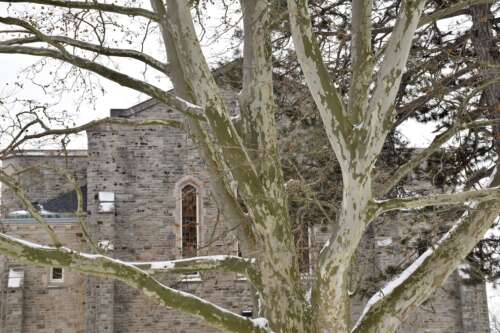
Driven by a love of trees and what he calls their exquisite beauty, Reinhart has been instrumental in turning the campus into an award-winner, recognized internationally for an outstanding landscape characterized by a rich diversity of trees.
“After I started at the University as a teenager, I just became obsessed with plants and couldn’t get enough of them,” said Reinhart, who drank in the wisdom of the landscaping pros on campus. He got his diploma in horticulture after high school, while continuing to work at the University.
He estimates that throughout his time at U of G, he had a hand in planting nearly half of all the trees currently alive and well on campus, including a towering row of maples along Gordon Street he helped plant when he was a teen.
“Beauty in a landscape is what I live for,” Reinhart said. He said he loves all the campus trees but his special favourite is the London plane tree, a relative of the sycamore, that stands behind War Memorial Hall.
U of G’s grounds have been entered several times in the Professional Grounds Management Society’s Green Star Awards, winning the Urban University Grounds category’s grand award for eastern North America in 2013 and 2017.
U of G Focused on Increasing Campus Tree Canopy
U of G is a tree-friendly environment, with a tree canopy that has grown exponentially over the years thanks to a tree protection policy that minimizes the felling of healthy trees, while replacing felled trees by a ratio of between three and five to one, depending on the tree’s environmental value.
Hundreds of trees are planted on the U of G campus each year. The University’s tree inventory map identifies every specimen on campus, its species and its condition.
Reinhart said all trees that are historically significant but must come down for one reason or another are posted with a sign explaining the reasons for cutting, and inviting comments and challenges.
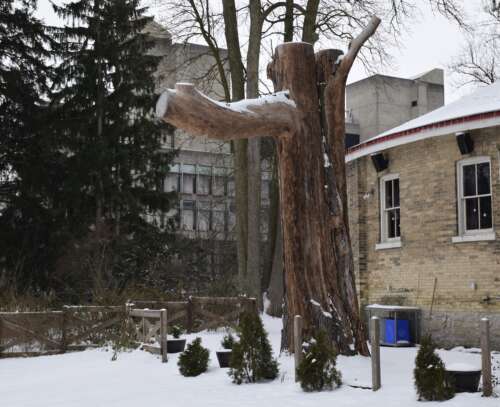
Trees need to be replaced for several reasons. Some become safety hazards because they are old and dying or weather damaged. Others are brought down by the wind or as part of preparations for construction projects, and yet others are decimated by insects such as the emerald ash borer.
Planting more trees than were lost enhances the beauty of the campus and has benefits for the environment. Brandon Raco, sustainability manager at U of G, said trees enhance urban biodiversity, providing other plants and animals with habitat, food and protection.
“Trees reduce the urban heat island effect by providing shade and cooling the surrounding conditions, making outdoor campus environments more comfortable in the summer,” he said.
Trees placed strategically near campus buildings can help reduce the energy required to cool those buildings, he added. Trees reduce stormwater runoff, improve air quality and absorb CO2.
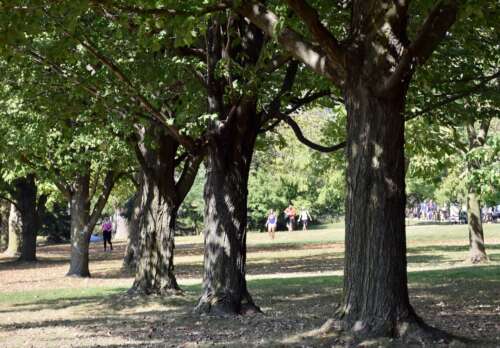
During the 1980s, Reinhart served as the University’s nursery keeper, growing trees that ended up alongside walkways and roads and on grounds throughout campus. The now towering silver maples that line Arboretum Road were grown by Reinhart in the nursery and then planted along the road when they were about three metres tall.
“It’s pretty incredible to walk around the campus and see all the trees I’ve had a hand in planting,” said Reinhart, the father of Gryphon football stars Job and Jake Reinhart. (Jake is currently with the Toronto Argonauts of the CFL. Job was drafted by the Calgary Stampeders.)
He has also been a part of solemn occasions in U of G’s tree history. During the ’80s, a double row of 100 sugar maples spanned Winegard Walk from College Avenue to South Ring Road East. Adverse conditions, including poor drainage, forced their elimination.
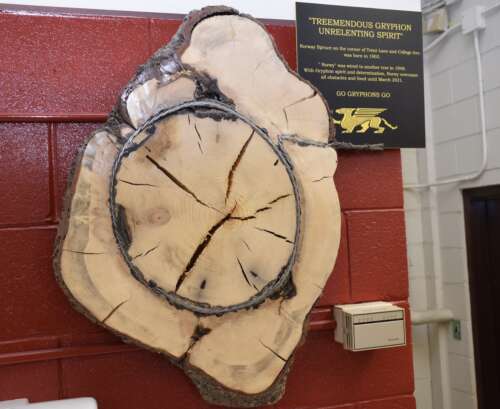
More recently, Reinhart led a memorial service and presented a eulogy for “Elmie,” an old red elm south of the Bullring. The historic tree was dying and had become a hazard.
Trees hold a lot of history within their rings, Reinhart said. Recently, an old spruce succumbed to age and had to be brought down by U of G arborist Mike Host. He found a steel cable embedded deep inside the tree. A round slice showing the embedded cable now hangs on a Grounds Department wall.
“It was an old spruce tree that was tied to another tree at the corner of Trent Lane and College Avenue,” Reinhart said. “Back in the ’40s, a cable was put around the tree to secure it. It grew around the cable until 2020, when it finally gave up the ghost.”
Responding to Tree Loss with New Landscape Projects
Many developments over the years have made up for the losses, including the Conservatory Garden, now a diverse centrepiece in the campus landscape. Reinhart calls the garden his “true love” and said gardener Nick Colley-Lussier works tirelessly to maintain it.
“Its location, plant selections and large green space in the heart of campus will one day become one of the most recognized gardens among all Canadian universities,” he said. “When I leave, that will be my biggest personal accomplishment.”
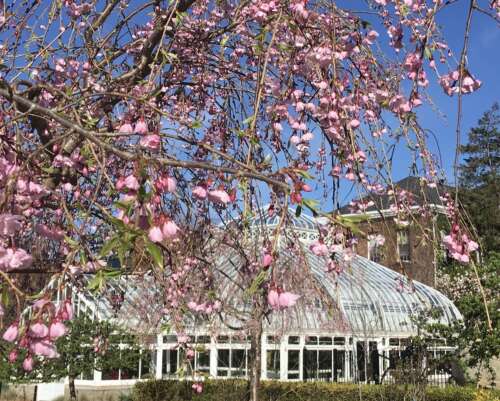
Development of the garden began in the ’90s, supported by U of G alumni. The garden’s hickory and osage orange trees, among many others including the cork trees along Christie Lane, were grown by Reinhart in the nursery.
“Diversity is huge,” said Reinhart, who perfected the practice of interplanting species like ash and oak on campus. Although the emerald ash borer decimated the ash population, the oak remained. Zelkova, a member of the elm family, was planted to replace the ash, but some ash on campus have survived.
Despite the inevitable loss of some trees each year – about 100 ash and several old pines, including one dating to the 1880s, have been lost recently — the number of trees on campus is increasing significantly. Most years, hundreds of trees are planted, including roughly 200 this fall.
“If the tree population on campus isn’t growing every year and flourishing, then I’m not doing my job,” Reinhart said. “That’s why I’m here. It’s what I love to do.”
Contacts:
John Reinhart
johnre@pr.uoguelph.ca
Brandon Raco
braco@pr.uoguelph.ca
